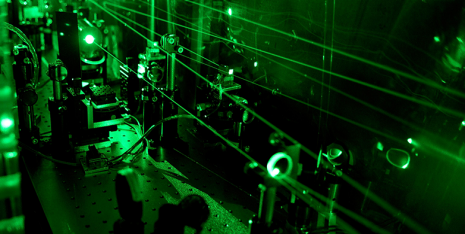Measuring deuteron more accurately than ever before
A deuteron is a very simple atomic nucleus made up of just one proton and one neutron — that is, one each of the two nuclear building blocks. An international research collaboration, working at the Paul Scherrer Institute PSI, has measured the deuteron more accurately than ever before. The value they obtained for the radius of the deuteron does not, however, correspond to the measurements of other research groups but instead shows a significantly smaller value.
In spite of this contradiction, there is also an agreement: In 2010 the same research group reported on the measurement of individual protons by means of the same method. Then, as well, the measurement clearly showed that the proton is smaller than had been thought to date. Since then, the research community has referred to this situation as “the proton radius puzzle.”
A further analysis of proton data from PSI confirmed the same small value in 2013.
So now it’s the deuteron, too. “No one in the community believes any more that our method, the laser spectroscopy, might be flawed,” PSI physicist Aldo Antognini asserts. And his research partner Randolf Pohl, who now works at the University of Mainz, adds:
“After our first study came out in 2010, I was afraid some veteran physicist would get in touch with us and point out our great blunder. But the years have passed, and so far nothing of the kind has happened.”
And now the new study — the measurement of the deuteron — also confirms the mystery of the proton radius. “You could say that the mystery has now doubly confirmed itself,” Pohl concludes.
Along with scientists at PSI, collaborators at ETH Zurich and the Max Planck Institute for Quantum Optics (Germany), as well as researchers in Paris, Coimbra (Portugal), Stuttgart (Germany), Freiburg (Switzerland), and Hsinchu (Taiwan) also had significant involvement in the study.
 Part of the laser system, which is required to determine the size of the deuteron. Invisible infrared laser pulses are converted into green laser light. (Photo: Paul Scherrer Institute / A. Antognini and F. Reiser)
Part of the laser system, which is required to determine the size of the deuteron. Invisible infrared laser pulses are converted into green laser light. (Photo: Paul Scherrer Institute / A. Antognini and F. Reiser)
New experiment creates excitement
The new research result is actually more than a doubling of the old mystery of the proton radius: Beyond that, it can further the search for the true nature of things.
“Naturally it can’t be that the deuteron — any more than the proton — has two different sizes,” says Antognini. Thus the scientific community is searching for explanations that can bring the different values back into harmony.
One possible explanation is that a physical force as yet unknown is at work. For the scientists, that is an exciting scenario; it is, however, highly improbable.
A more obvious explanation would be experimental imprecision. “Actually, the mystery could be solved very easily if we assume a minimal experimental problem with the hydrogen spectroscopy,” Antognini explains. Some of the earlier measurements, of both the proton’s size and the deuteron’s size, were based on this method.
Another method for determining the sizes of the proton and the deuteron uses electron scattering. The deuteron size that was measured via electron scattering is in fact compatible with the new value obtained by the PSI research group, but there is comparatively large uncertainty about its overall accuracy.
To crack the riddle of the proton radius, several research groups who use hydrogen spectroscopy or electron scattering began, some years ago, to upgrade their experiments and improve their precision. Antognini and Pohl are proud of that:
“If our value had agreed with the previous ones, there would not have been this darned mystery of the proton radius; but there also never would have been this worldwide surge of activity that has led to several highly accurate measurement setups,” Pohl says.
Currently research groups in Munich, Paris, and Toronto are working to obtain more accurate measurements via hydrogen spectroscopy. Their results are expected in the coming years.
Physical constants might need to be adjusted
“If it should actually turn out that the hydrogen spectroscopy is giving a false — that is, minimally shifted — value, that would mean that the Rydberg constant must be minimally changed,” Antognini explains. The Rydberg constant and the proton radius are two physical quantities that are strongly coupled to each other.
To date, among all physical constants, the Rydberg constant is the one that has been determined with the highest precision: Even its eleventh decimal place is already known.
Still, thanks to the mystery of the proton radius, this last decimal place could still change a bit. That would have consequences for many areas of physics and would lead to minimal corrections for other constants of nature.
It took world’s most powerful muon source
To determine the size of the deuteron at PSI, the researchers first produced artificial atoms: muonic deuterium. These atoms have a nucleus of one deuteron, which is orbited by one muon.
The muon source of PSI is the most high-performance system of its kind in the world.
Thanks to this, it was possible to inject around 300 muons per second into the experiment chamber. There they hit atoms of gaseous deuterium, flung their electrons out, and took their place. The result was atoms of muonic deuterium.
Muons are negatively charged elementary particles that strongly resemble electrons but are around 200 times heavier. Because of their higher mass, the muons move much closer to the atomic nucleus, and the properties of their orbits depend much more strongly on the size of this nucleus.










